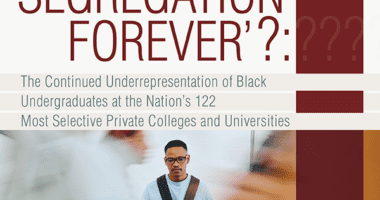Which States Make the Grade When It Comes to Enrolling and Graduating Latino College Students?
None of Them, According to New Ed Trust Research
WASHINGTON (September 11, 2019) — When it comes to enrolling and graduating Latinos, public colleges and universities in most states are flunking, according to new research by The Education Trust. At a time when the Latino population in the U.S. is fast increasing, Latinos are neither getting their fair share of seats nor their fair share of degrees from public institutions of higher education in nearly every state when compared with state demographics and White peers.
“A college degree is the surest path to the middle class. The fact that Latinos don’t have equitable access to enrolling in college and earning a college degree means millions of Latinos are missing out on the best chance to move into the middle class,” said Wil Del Pilar, vice president of higher education at The Education Trust. “This isn’t just damaging to Latinos. This systematic inequality threatens our democracy and our economy. It’s time for state leaders to act.”
Earlier Ed Trust research showed that Black and Latino adults are less likely to hold a college degree today than White adults were in 1990. And the first Broken Mirrors report exposed the systematic underrepresentation of Black students and graduates in public colleges and universities. Now, Broken Mirrors II: Latino Student Representation at Public State Colleges and Universities details how much work states have to do to increase the population of Latinos with a college degree, from enrolling proportional numbers of Latinos in community colleges and four-year colleges and universities to ensuring Latinos are just as likely as their White peers to cross the finish line once they start college.
For Broken Mirrors II: Latino Student Representation at Public State Colleges and Universities, Ed Trust analyzed publicly available census and federal higher education data to determine how well Latino residents are represented in public community and technical colleges and public four-year colleges and universities. The Ed Trust research team gathered data and assigned grades to states in several areas. Key findings show:
- Latino students are underrepresented at public colleges and universities, especially at community and technical colleges, in the vast majority of states. In 40 of the 44 states (or 90%) examined, Latino students are underrepresented at community and technical colleges. In 33 of the 44 states (or 75%), Latino enrollment at four-year public institutions is not on par with the state’s proportion of Latino residents.
- The states with the largest Latino populations fail to provide Latino students with the same access to selective public four-year institutions as their White peers. Four of the eight states (California, Texas, Florida, and New York) with enrollment gaps of 10 percentage points or more between Latino and White students were states that accounted for more than 61% of the Latino population. Texas, California, and Florida received an “F” on this measure. New York earned a “D.”
- In all 44 of the states we examined, Latinos are underrepresented among associate and bachelor’s degree earners. Underrepresentation was worse at the bachelor’s degree level in 14 states. These states are home to nearly 68% of the country’s Latinos who do not have a college degree.
- A smaller share of Latino graduates received a bachelor’s degree compared to their White peers in most states. Nine states (Arizona, Colorado, Connecticut, Hawaii, Kansas, Massachusetts, Minnesota, Nebraska, and Texas) have double-digit gaps between the shares of Latino and White graduates who are awarded a bachelor’s degree. In these states, Latino graduates disproportionately receive associate degrees and certificates, which can be less economically valuable than bachelor’s degrees.
- On a more positive note, several states with sizable Latino populations are close to meeting Ed Trust’s equity benchmarks.
- California, Texas, and Florida have larger Latino populations and scored above the state average on Latino enrollment representation at community and technical colleges. Among those states, Florida earned the highest score for enrollment of Latinos in two-year public colleges compared to the broader population.
- Within the public four-year sector, Kentucky, Iowa, Florida, Arkansas, and New York are the highest performers, with Latino enrollment shares that approach or exceed their population benchmarks. New Mexico has the largest share of Latino residents among the 50 U.S. states (at 53%) and also scores relatively well on Latino enrollment representation at public four-year institutions.
- Several states with a substantial population of Latino residents are in the top 10 for Latino representation among associate degree earners — Florida, Texas, New Mexico, New York, and California.
- New Mexico and Florida also stand out for awarding bachelor’s degrees to Latinos in nearly proportional numbers.
Broken Mirrors II calls on states to ask a number of tough questions to understand the root causes of enrollment and degree disparities among Latinos, and Ed Trust urges states to take immediate action on at least these four fronts:
- setting race and ethnicity targets in statewide college degree attainment goals,
- rewarding public colleges and universities for enrolling and graduating students of color,
- ensuring residents with some college but no degree are eligible for need-based aid programs
- investing in community college programs that help residents earn high school equivalency credentials and get on a pathway to higher education.
“Some of this is pretty straight forward in terms of what states need to do to increase college enrollment and college degrees among Latinos in public higher ed. For starters, every state in the country should set measurable race and ethnicity targets as part of statewide college degree attainment goals,” said Del Pilar. “States should reward colleges for enrolling and graduating students of color in performance funding formulas.
“State lawmakers should ensure residents with some college and no degree – not only recent high school graduates – are eligible for need-based aid so they can return to college and complete their degree. And, given the large number of Latinos without a high school diploma, states should invest in community college programs that help residents earn a high school equivalency credential and get on a pathway to higher education.”
“The nation’s nearly 60 million Latinos deserve access to an excellent education, from pre-school through post-secondary,” said Arturo Vargas, Chief Executive Officer of NALEO Educational Fund. “As this new Ed Trust report outlines, states must do better in serving Latino students when it comes to access and success in public higher education. NALEO Educational Fund will continue to work towards this goal by supporting Latino elected and appointed officials as they develop and enact policies to improve academic opportunity and success among our community.”
“Universal and quality public education, from early learning through college, is the foundation for lifelong success,” said Sindy Benavides, Chief Executive Officer of the League of United Latin American Citizens (LULAC). “Unfortunately, as this new Ed Trust report makes clear, Latino families and communities are systematically excluded from public higher education in nearly every state. It’s about time policy makers ensured equal opportunity for access to a college degree. One needed step forward is making Pell Grants and state scholarships available to all qualified students regardless of citizenship status.”
“By 2023, Latinos will represent nearly 30% of all students enrolled in U.S. schools,” said Janet Murguía, President and CEO of UnidosUS. “The vast majority of those students want to go onto college once they finish high school, and they all deserve the chance to earn a high-quality college degree. New research from Ed Trust shows that, in nearly every state, our public colleges and universities have a lot of work to do to provide equitable college access for Latinos. Our nation’s diversity is our strength. State leaders should make college access and success for Latinos a top priority, and Congress must invest in students of color.”
Interactive data visualizations showing how well states serve Black and Latino residents – and how many Black and Latino students and graduates states would have to add to achieve proportional representation – are available in the State Equity Report Card at www.StateEquity.org.
###








